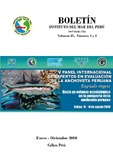Por favor, use este identificador para citar o enlazar este ítem:
https://hdl.handle.net/20.500.12958/1101Registro completo de metadatos
| Campo DC | Valor | Lengua/Idioma |
|---|---|---|
| dc.contributor.author | Tam Málaga, Jorge | |
| dc.contributor.author | Blaskovic' Huayta, Verónica | |
| dc.contributor.author | Goya Sueyoshi, Elisa | |
| dc.contributor.author | Bouchon Corrales, Marilú | |
| dc.contributor.author | Taylor, Marc | |
| dc.contributor.author | Oliveros Ramos, Ricardo | |
| dc.contributor.author | Guevara Carrasco, Renato | |
| dc.contributor.author | Purca Cuicapusa, Sara | |
| dc.date.accessioned | 2012-11-16T12:35:16Z | |
| dc.date.available | 2012-11-16T12:35:16Z | |
| dc.date.issued | 2010-12 | |
| dc.identifier.citation | Bol Inst Mar Perú 25(1-2) 2010: 31-37 | |
| dc.identifier.issn | 0378-7699 | |
| dc.identifier.uri | https://hdl.handle.net/20.500.12958/1101 | |
| dc.description | Boletín IMARPE vol. 25, nº 1-2, 2010; p. 31-37 | es_ES |
| dc.description.abstract | Se hipotetiza que la mortalidad por pesca ocasiona efectos ecosistémicos, no sólo sobre la anchoveta, sino también sobre otros componentes del ecosistema, tales como los depredadores tope. El objetivo es realizar simulaciones con un modelo ecotrófico multiespecífico cubriendo el decenio de los años 2000, cambiando la mortalidad por pesca y analizando las variaciones en la biomasa de anchoveta, aves guaneras y lobos marinos. Se usó el Índice de Oscilación Peruano (IOP) para incluir una mediación que afecte la vulnerabilidad de las presas de la anchoveta. Se comparó el ajuste de los datos observados, usando dos tipos de dieta para anchoveta (fitoplanctófaga y zooplanctófaga). Se realizaron proyecciones de la biomasa, cambiando la mortalidad por pesca de 0,0 a 1,4 año-1. Las simulaciones con la dieta zooplanctófaga, que eleva el nivel trófico de la anchoveta de 2,35 a 3,36, produjo un menor ajuste entre los datos observados y simulados. La relación inversa entre la mortalidad por pesca y la biomasa desovante de la anchoveta, mostró que mortalidades por pesca entre 0,8 y 1,4 año-1 estarían asociadas a una biomasa desovante mínima de anchoveta, tomando en consideración sus relaciones multiespecíficas. También se encontró una relación inversa entre la mortalidad por pesca y las poblaciones de aves guaneras y lobos marinos. | es_ES |
| dc.description.abstract | ABSTRACT: It is hypothesized that the fishing mortality has ecosystem effects, not only on the anchovy but also on other ecosystem components, such as top predators. The objective is to carry out simulations with a multispecific ecotrophic model for the decade of the years 2000, changing fishery mortality and analyzing biomass variations in seabirds and pinnipeds. The Peruvian Oscillation Index was used to include a mediation affecting the vulnerability of anchovy preys. The fit of observed data was compared using two types of anchovy diet (phytoplanktophagous and zooplanktophagous). Biomass projections were carried out varying fishing mortality from 0,0 to 1,4 y-1. Simulations with the zooplanktophagous diet, which increased the trophic level of the anchovy from 2,35 to 3,36, produced a lower fit between observed and simulated data. The inverse relationship between fishing mortality and anchovy spawning biomass showed that fishing mortalities between 0,8 and 1,4 y-1 were associated to a minimum spawning biomass of anchovy, taking into account its multispecific relationships. An inverse relationship was also found between the fishing mortality and populations of seabirds and pinnipeds. | |
| dc.language.iso | spa | es_ES |
| dc.publisher | Instituto del Mar del Perú | es_ES |
| dc.relation.ispartofseries | Boletín IMARPE vol. 25, nº 1-2, 2010; p. 31-37 | |
| dc.rights | info:eu-repo/semantics/openAccess | |
| dc.rights.uri | https://creativecommons.org/licenses/by/4.0/ | |
| dc.source | Instituto del Mar del Perú - IMARPE | |
| dc.source.uri | Repositorio Digital IMARPE | |
| dc.subject | Modelo Ecotrófico | es_ES |
| dc.subject | Ecosistema Marino | es_ES |
| dc.subject | Corriente De Humboldt | |
| dc.subject | Anchoveta | |
| dc.title | Relación entre anchoveta y otros componentes del ecosistema | es_ES |
| dc.title.alternative | Relationship between anchovy and other components of the ecosystem | es_ES |
| dc.type | info:eu-repo/semantics/article | es_ES |
| Aparece en las colecciones: | Boletín 25(1-2), 2010 | |
Ficheros en este ítem:
| Fichero | Descripción | Tamaño | Formato | |
|---|---|---|---|---|
| BOL 25(1-2)-4.pdf | 1 MB | Adobe PDF |  Visualizar/Abrir |
Este ítem está sujeto a una licencia Creative Commons Licencia Creative Commons

